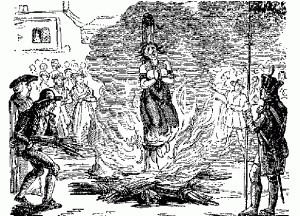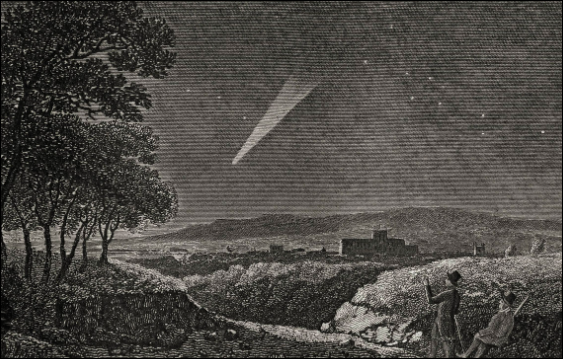
From the Middle Ages the penalty for the murder of a wife by a husband was to be hanged by the neck until dead, but the murder of a husband by a wife was another matter. Just as the King was God’s representative on earth so the Man was the King’s representative in the household. The murder of a husband by his wife was therefore not only murder but petty treason for which the penalty was to be burnt at the stake.
On 16 October 1722 a man named as James Lumock[1] was buried at St Philip and St Jacob’s, a parish so large that it was divided into two parts. The ‘in’ parish lay within the confines of Bristol; the district ‘without’ was situated east of the City beyond Lawford’s Gate and sprawled far into the badlands of Kingswood and thus came under the jurisdiction of the County of Gloucestershire.
Though sudden death came as no stranger at this time James Lumock’s departure aroused tittle-tattle among the neighbours. One whispered to another that his wife Jane was ‘no better than she should be’, that she had been overheard on occasions threatening to kill him. Within a week of James’ death the local news reported that Jane Lumock ……
‘……from Larford’s [sic] Gate near Bristol is committed to this County Gaol, (i.e. Gloucester) for barbarously murdering her Husband, by cutting open his Guts. One John Hardwick is also committed, for being an Accomplice in the same Fact.’
In most cases ‘justice’ was swift and sentence immediate. In Jane’s case, unusually, the matter did not reach court until the following October, six months to the day of her husband’s burial, which may reflect the gravity of her situation. The man who was previously reported as Hardwick, her accomplice, seems to be the same man, now called John Harding, who swore that Jane had murdered her husband by stabbing him in the belly, that she
‘……had desired him [Harding] to hide the knife in the garden, for fear it should be discover’d.’
After Harding/Hardwick gave his damning testimony, Jane, apparently rendered speechless through terror ‘said very little to the Purpose in her Defence’. She was convicted on the hearsay evidence given by a very doubtful character of killing her husband by
‘one mortal wound on the Navel with a knife’
and
‘……being a Person of a very bad Character, the Jury brought her in Guilty of Wilful Murder.’
To which was added the awful three word sentence ‘To be burnt.’
The sentence was carried out in less than a fortnight. Jane was brought to the place of execution in Gloucester with a male felon and a girl convicted of the murder of her bastard child who were to be hanged.
Those in power, secular and religious, liked nothing better than an admission of guilt and contrition to tidy things up. Perhaps to salve any vestige of conscience, even doubt that the right person was being despatched, they hoped a confession would be forthcoming even up to the scaffold. In this case they were denied. All three protested their innocence. Jane
‘…..likewise denied the Fact, and behaved herself very stubborn, from the time of her receiving Sentence to the place of Execution.’[2]
The newspaper is silent on the details of Jane Lumock’s death. For a horrific description we need to travel in time to a later date, 40 years hence and to Ilchester, Somerset.
Mary Norwood, aged about 33, was convicted of poisoning her husband Joseph. At three o’clock on a May afternoon in 1765 she was brought barefoot from the gaol at Ilchester before a crowd of 8,000 spectators. She was covered with a tarred cloth made up like a shift and a tarred bonnet was placed on her head. Her legs, feet and arms were likewise daubed with tar. It was unseasonably warm and the heat melted the tar on her bonnet so that it ran down her face. She was placed on a hurdle and drawn to the place of execution. After spending some time in prayer and singing a hymn the executioner placed her on a tar barrel about three feet high. A rope ran on a pulley through which a stake was fixed about her neck, with herself placing it properly with her hands. Three irons were fastened round her body to confine it to the stake that it might not drop as the rope burnt.
‘As soon as this was done, the fire was immediately kindled, but in all probability the woman was dead before the fire reached her, as the executioner pulled her body several times as the irons were being fixed. The fire burned with amazing fury and a great part of her could be observed for nearly an hour.
‘Nothing could be more affecting to behold after her bowels fell out, the fire flaming between her ribs and issuing out of her eye holes and ears and mouth. In short such a terrible sight that great number turned their backs not able to look at it.’[3]
Other newspapers gave a less lurid report:
Mary, who was born near Cardiff, married her husband, who was 60 when he died, at the age of eighteen. For ten years it is said they lived happily together in Axbridge, until she …..
‘…..became acquainted with one H—–, a shoemaker, who seduced her and who she charged with being the author of her unhappy end. That she frequently eloped from her husband and spent his substance on H—–. That she and H—– tried to strangle him, H—– declaring he would marry her if she rid herself of her husband; on this she bought poison and gave it to him in warm milk of which he died two days later.’
‘she was drawn on a sledge to the place of execution where she behaved with uncommon fortitude. After joining in saying prayers and singing a hymn, she was strangled: but the fire was not kindled till after she was dead sometime. As a dying woman she earnestly recommended to H—— a sincere repentance for his past transgression.’ [4]
Joseph Norwood was buried at Axbridge, 8 November 1764. ‘H’ the alleged seducer, was never identified.
Strangulation by the executioner before the fire was lit was usual as an act of mercy.
The crime of petty treason was defined in an Act of 1351 during the reign of Edward III. It applied not only to wives who killed their husbands but also to servants who killed their master or mistress. Females were also burnt for ‘coining’, producing counterfeit money. The last woman to be burnt at the stake in England and Wales was Catherine Murphy for counterfeiting in 1789.
The vast majority of women who were executed were hanged for murdering their bastard child.
Anne Williams was the last woman in Gloucestershire to be burnt at the stake, (1753). The illustration (in the header) implies she was fully conscious, but this was probably not the case.
———————————————
Acknowledgement: The story of Mary Norwood appeared in BAFHS Journal no. 100, June 2000. At that time I was unaware of the Bristol woman Jane Lumock who endured the same cruel punishment.
[1] This surname comes in many forms. James was buried as ‘Lumock’ in the parish register. As rendered by the Glos. Journal Jane was ‘Limmock’ in her original indictment and ‘Leamoucks’ in the report of her trial and execution. The couple’s supposed child, Deborah, buried 5 May 1726, (PR) was ‘Lumack’. I have used the form ‘Lumock’ in the text for simplicity but I suspect we would recognise the surname nowadays as ‘Lomax’.
[2] Glos Journal 11.10.1722, 18.3.1723, 1.4.1723
[3] Bristol Journal 18.5.1765
[4] Aberdeen Press 27.5.1765 and other newspapers.








Leave a Comment